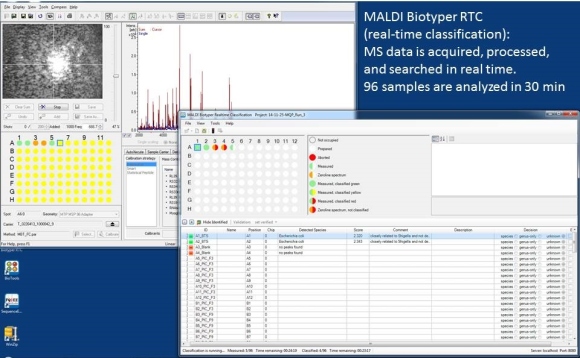If you are interested in learning how proteins are identified using mass-spectrometry-based proteomics, Proteome Software website has an excellent collection of short and informative essays.
Category Archives: Resources
Elemental composition analysis
Our facility is not equipped to perform elemental analysis. Fortunately, there are other facilities that can help you, for example ICP-MS Facility or Materials Characterization Lab.

Biotyper
The MALDI Biotyper identifies microorganisms by analyzing their intrinsic proteins using mass spectrometry.
An individual colony from an overnight culture grown on an agar plate is picked using a wooden toothpick and transferred to a MALDI target. This sample is allowed to dry, and a microliter of a matrix solution is added to the sample. The organic solvent in the matrix solution extracts proteins from the microorganisms. The extracted proteins are mainly ribosomal proteins, present in high concentrations. Once the matrix has crystallized, sample preparation is complete and the samples are ready for analysis. For some microorganisms, it is necessary to perform a more extensive extraction, which adds another 10-15 minutes to the sample preparation procedure.
In our facility, the analyses are carried out on the Bruker Ultraflextreme MALDI TOF/TOF mass spectrometer. Each MALDI mass spectrum is a species-specific molecular fingerprint, a mass and intensity distribution of peaks corresponding to mainly ribosomal proteins.

Microorganisms are identified in real time as soon as data are collected from each individual target position.
Identification of an unknown microorganism is based on comparing the experimental molecular fingerprint with 6903 fingerprints in the Biotyper library and assigning a score which represents the probability that the match is correct.

Off-line classification software provides additional options for working with data such as creating new library entries, re-organizing libraries, viewing mass spectra, or assessing quality of match.
The algorithm used to compare patterns computes three separate values for three fundamental characteristics of the sample spectra and the reference spectra: the number of signals in the reference spectrum that have a closely matching partner in the unknown spectrum; the number of signals in the unknown spectrum that have a closely matching partner in the reference spectrum; and the intensity symmetry of the matching pairs. The maximum obtainable score is 3, and the score values greater or equal to 2 are considered as a probable identification.

Each mass spectrum is converted into a histogram which represents the mass and intensity ‘fingerprint’.
Biotyper software allows building spectral libraries of any type of samples as long as the samples are amenable to MALDI-TOF MS and produce unique MS fingerprints. If you are interested in learning more about MALDI MS and the Biotyper, please contact Tatiana.
The acquisition of MALDI Biotyper software was possible through collaboration with Dr. Bhushan M. Jayarao, Director of Penn State Animal Diagnostic Laboratory, Professor of Veterinary and Biomedical Sciences.
Featured image credit: Rocky Mountain Laboratories, NIAID, NIH
Scanning electron micrograph of Escherichia coli, grown in culture and adhered to a coverslip
Plate reader
The SpectraMax M5 plate reader is currently unavailable.
The SpectraMax M5 Multi-Mode Microplate Reader delivers single mode reader performance in one multimode reader package. The dual monochromator optics allow the widest range of applications to be utilized for bioresearch and drug discovery applications, all without the need to change filters. The SpectraMax M5 Multi-Mode Microplate Reader possesses the five modes preferred by the majority of our users providing the benefit of multiple detection modes in one platform:
UV-Visible Absorbance (Abs)
Fluorescence Intensity (FI)
Time-Resolved Fluorescence (TRF)
Fluorescence Polarization (FP)
Glow Luminescence (Lumi)
Resources: Custom peptide synthesis and more
I would like to share with you a resource for custom peptides and other life sciences research products that might save you a few dollars. As always, a disclaimer: I don’t promote any products or services on this blog and I don’t accept any form of compensation for sharing this information.
The following is contributed by Dr. Ann McPherson, Territory Sales Associate Biotech/Pharmaceutical Accounts Specialist for Bio Basic
“Bio Basic is a one-stop-shop for customers doing research in the life sciences field. We distinguish ourselves from other one-stop-shops in three main ways:
Manufacturing. We have ten product lines, eight of which are manufactured within our state-of-the-art facility.
Lowest price for all product lines. By directly manufacturing most of our products, we’re able to offer the lowest prices to our customers.
Strict quality control. All of our products are Quality Control tested before shipping. Bio Basic is also ISO9001 certified, which means that we’re regularly audited for third party assessment purposes that certify that we adhere to the method and model of quality management published by the International Organization for Standardization.
Information on our products and services can be found on our website. If you e-mail me (biotech@biobasic.com) with the specific products and services that you’re interested in, I can provide more information and may be able to offer an additional discount. For now, I would like to make users of Penn State’s Proteomics and Mass Spectrometry Core Facility aware of two promotions that we have until Dec. 31st, 2013:
“Buy 2 get 1 FREE!” on all of our products (excludes our services: Gene Synthesis, Oligo Synthesis, DNA Sequencing, Peptide Synthesis, Protein Purification, Antibody Services). Use the quote number FBG2013ANN when ordering.
30% off of all recombinant proteins! Use the quote number PRTN30ANN when ordering (minimum $45 order).
You can find out about our range of recombinant proteins here.
For various cytokines, look under the chemokine, interleukin, interferon, tumor necrosis factor, colony stimulatory factor (CSF), etc. categories.”

